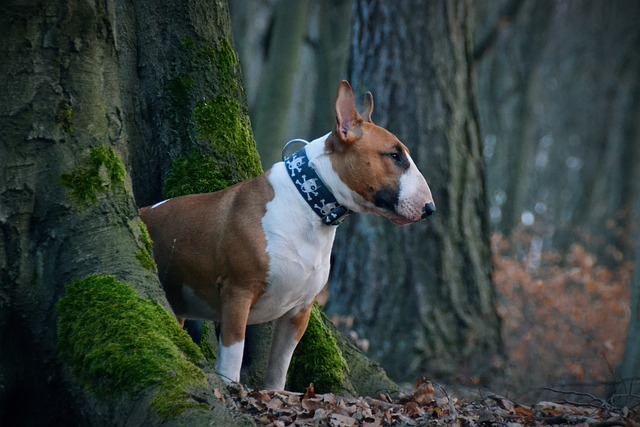


The Bull Terrier is a distinctive and strong-willed dog breed known for its unique egg-shaped head and muscular body. Originally bred for bull-baiting and later as a companion dog, the Bull Terrier has evolved into a loyal and energetic pet. Despite its tough appearance, the Bull Terrier is playful, affectionate, and full of personality. They are well-suited for active families or individuals who are prepared to provide them with both physical and mental stimulation. Their spirited nature and sometimes stubborn demeanor make them an intriguing and rewarding breed for experienced dog owners.
The Bull Terrier was first developed in England in the early 19th century. It was originally bred by crossing the Old English Bulldog with the now-extinct English White Terrier, resulting in a dog with a powerful build and strong hunting instincts. Initially, Bull Terriers were used for bull-baiting, a cruel and dangerous sport, but after the practice was banned in 1835, the breed was repurposed as a companion dog and a small game hunter. In the late 19th century, breeders began focusing on refining the breed’s distinctive features, including its iconic head shape, leading to the Bull Terrier’s modern appearance. Today, the Bull Terrier is known for its affectionate, loyal, and playful nature, despite its tough exterior.
The Bull Terrier is a medium-sized dog with a muscular and athletic build. Adult males typically weigh between 50 to 70 pounds, while females are slightly smaller, ranging from 35 to 50 pounds. The breed is well-balanced with a deep, broad chest and strong legs, making it agile and powerful. One of the most recognizable features of the Bull Terrier is its large, egg-shaped head, which is smooth and muscular, with a straight, short muzzle. Its eyes are small, triangular, and dark, giving it an intense yet friendly expression. The coat is short, dense, and smooth, usually white or with colorful markings in shades of black, brown, or brindle. The Bull Terrier’s tail is short, thick at the base, and tapers to a point, often carried low or horizontally.
The Bull Terrier is known for its bold, confident, and sometimes stubborn personality. While it may appear tough and aggressive, the Bull Terrier is generally a loving and playful companion, especially with family members. They are often described as “clownish” in nature, with a strong sense of humor and a desire to entertain. Bull Terriers tend to form strong bonds with their owners and are known to be affectionate and loyal. They are often good with children and can be sociable with other pets if properly socialized. However, the breed's independent nature and high energy levels may make them challenging for novice dog owners to manage. Early training and consistent leadership are essential to ensure the Bull Terrier grows up to be a well-behaved and balanced dog.
The Bull Terrier is an active and energetic breed that requires regular exercise to maintain both physical and mental health. They enjoy daily walks, runs, and play sessions in a securely fenced yard. Due to their high energy levels, Bull Terriers thrive on activities that engage them mentally and physically, such as interactive games and obedience training. Without sufficient exercise and stimulation, Bull Terriers may become bored, which could lead to undesirable behaviors like chewing or digging. Because they are strong and determined, it is important to provide a safe and controlled environment during outdoor activities to ensure they do not chase after small animals or wander off. The breed is also known for excelling in canine sports, such as agility or obedience trials, if properly trained.
Training a Bull Terrier requires patience, consistency, and positive reinforcement. While the breed is intelligent, its independent nature can make training a challenge. Bull Terriers may be stubborn or willful at times, so it is important for owners to establish clear boundaries and use reward-based training methods to encourage desired behaviors. Early socialization is crucial for helping the Bull Terrier become comfortable with other dogs, pets, and strangers. Socialization should begin at an early age to ensure that the dog grows up to be well-rounded and confident. Obedience training should also be a priority to teach the Bull Terrier basic commands and prevent undesirable behaviors, such as jumping or pulling on the leash. With the right training and leadership, the Bull Terrier can become a loyal and well-behaved companion.
The Bull Terrier is generally a healthy breed, but like all dogs, it is prone to certain health issues. Common health concerns for Bull Terriers include hip dysplasia, patellar luxation, and heart disease. They may also be prone to skin issues, such as allergies or rashes, especially if their coat is not regularly maintained. Regular veterinary check-ups are essential to monitor the Bull Terrier's health, and responsible breeders will test for genetic conditions to reduce the risk of inherited diseases. The Bull Terrier's coat is easy to care for, requiring only occasional brushing to remove loose hair. However, their ears should be checked regularly for signs of infection, and their teeth should be brushed to maintain good oral health. As with all breeds, it is important to provide a nutritious diet and plenty of exercise to keep the Bull Terrier in optimal health.
The typical lifespan of a Bull Terrier is around 10 to 14 years. With proper care, including regular exercise, a balanced diet, and routine veterinary visits, many Bull Terriers live into their early teens. Like all breeds, Bull Terriers are susceptible to certain health conditions that can affect their lifespan. Early detection of health issues, along with proper management and treatment, can help extend the dog's life and ensure that it remains active and healthy throughout its senior years.
© copyright Dog Compendium 2024 - 2025